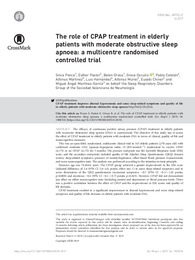Por favor, use este identificador para citar o enlazar este ítem:
https://hdl.handle.net/11000/34877Registro completo de metadatos
| Campo DC | Valor | Lengua/Idioma |
|---|---|---|
| dc.contributor.author | Ponce, Silvia | - |
| dc.contributor.author | Pastor, Esther | - |
| dc.contributor.author | Orosa, Belén | - |
| dc.contributor.author | Oscullo, Grace | - |
| dc.contributor.author | Catalán, Pablo | - |
| dc.contributor.author | Martinez, Alfonso | - |
| dc.contributor.author | Hernandez Blasco, Luis M. | - |
| dc.contributor.author | Muriel, Alfonso | - |
| dc.contributor.author | Chiner, Eusebi | - |
| dc.contributor.author | Martínez-García, Miguel Ángel | - |
| dc.contributor.author | Sleep Respiratory Disorders Group of the Sociedad Valenciana de Neumología | - |
| dc.contributor.other | Departamentos de la UMH::Medicina Clínica | es_ES |
| dc.date.accessioned | 2025-01-18T08:35:11Z | - |
| dc.date.available | 2025-01-18T08:35:11Z | - |
| dc.date.created | 2019 | - |
| dc.identifier.citation | European Respiratory Journal. 2019 Aug 22;54(2):1900518 | es_ES |
| dc.identifier.issn | 1399-3003 | - |
| dc.identifier.issn | 0903-1936 | - |
| dc.identifier.uri | https://hdl.handle.net/11000/34877 | - |
| dc.description.abstract | The efficacy of continuous positive airway pressure (CPAP) treatment in elderly patients with nonsevere obstructive sleep apnoea (OSA) is controversial. The objective of this study was to assess the effect of CPAP treatment in elderly patients with moderate OSA in terms of clinical, quality-of-life and neurocognitive measures.This was an open-label, randomised, multicentre clinical trial in 145 elderly patients (≥70 years old) with confirmed moderate OSA (apnoea-hypopnoea index 15-29.9 events·h-1) randomised to receive CPAP (n=73) or no CPAP (n=72) for 3 months. The primary end-point was the Epworth Sleepiness Scale (ESS) score, and the secondary end-points included quality of life (Quebec Sleep Questionnaire (QSQ) domain scores), sleep-related symptoms, presence of anxiety/depression, office-based blood pressure measurements and some neurocognitive tests. The analysis was performed according to the intention-to-treat principle.Mean±sd age was 74.9±4.6 years. The CPAP group achieved a greater improvement in the ESS score (adjusted difference of 2.6 (95% CI 3.6-1.6) points; effect size 1) in some sleep-related symptoms and in some dimensions of the QSQ questionnaire (nocturnal symptoms: -0.7 (95% CI -0.3--1.0) points; p<0.0001 and emotions: -0.4 (95% CI -0.1--0.7) points; p=0.023). However, CPAP did not demonstrate any effect on either neurocognitive tests (including anxiety and depression) or blood pressure levels. There was a positive correlation between the effect of CPAP and the improvement in ESS scores and quality of life domains.CPAP treatment resulted in a significant improvement in diurnal hypersomnia and some sleep-related symptoms and quality of life domains in elderly patients with moderate OSA. | es_ES |
| dc.format | application/pdf | es_ES |
| dc.format.extent | 10 | es_ES |
| dc.language.iso | eng | es_ES |
| dc.publisher | European Respiratory Society | es_ES |
| dc.rights | info:eu-repo/semantics/openAccess | es_ES |
| dc.rights | Attribution-NonCommercial-NoDerivatives 4.0 Internacional | * |
| dc.rights.uri | http://creativecommons.org/licenses/by-nc-nd/4.0/ | * |
| dc.title | The role of CPAP treatment in elderly patients with moderate obstructive sleep apnoea: a multicentre randomised controlled trial | es_ES |
| dc.type | info:eu-repo/semantics/article | es_ES |
| dc.relation.publisherversion | 10.1183/13993003.00518-2019 | es_ES |

Ver/Abrir:
The role of CPAP treatment in elderly patients with moderate obstructive sleep apnoea. A multicentre randomised controlled trial.pdf
529,39 kB
Adobe PDF
Compartir:
 La licencia se describe como: Atribución-NonComercial-NoDerivada 4.0 Internacional.
La licencia se describe como: Atribución-NonComercial-NoDerivada 4.0 Internacional.
.png)